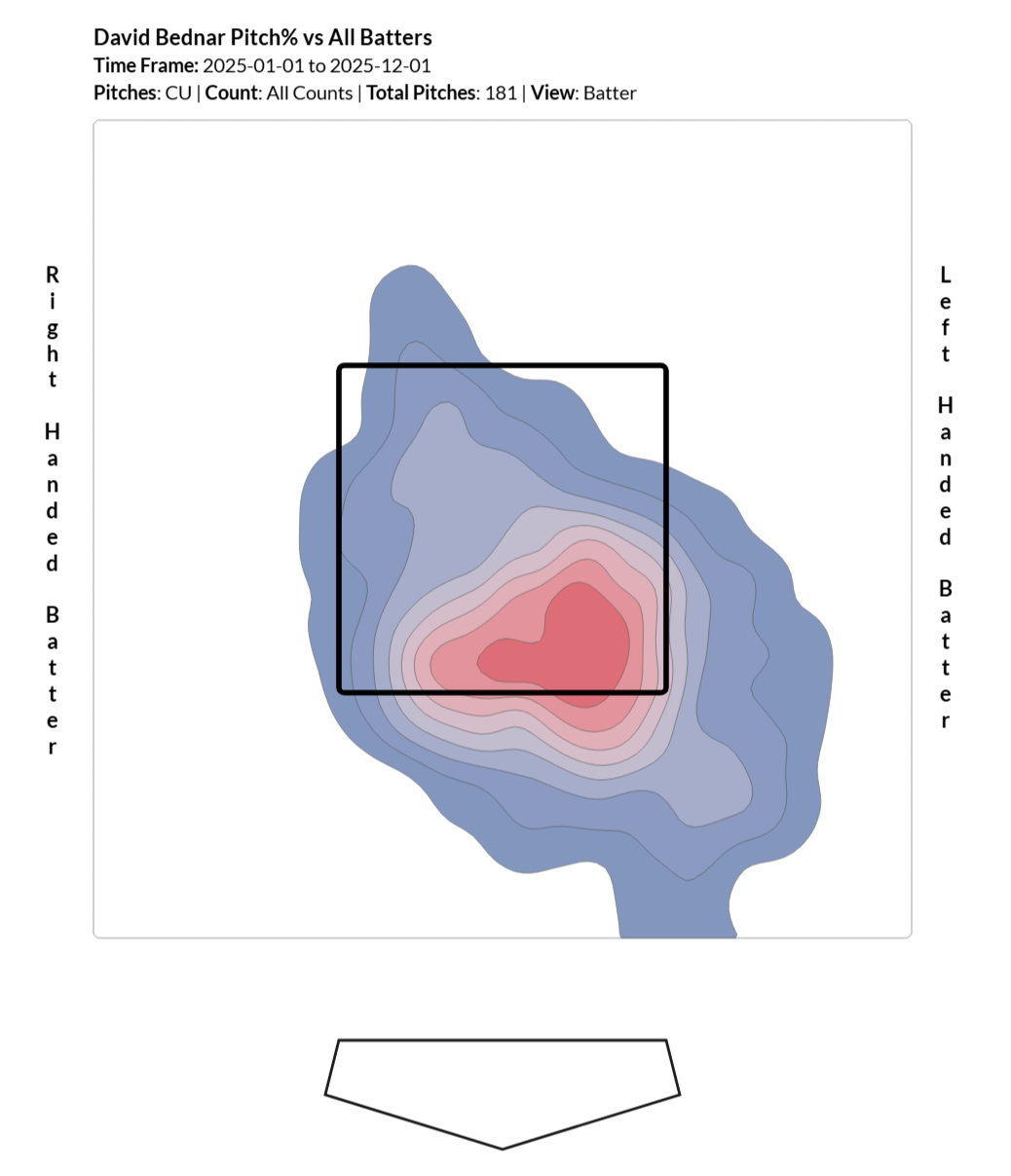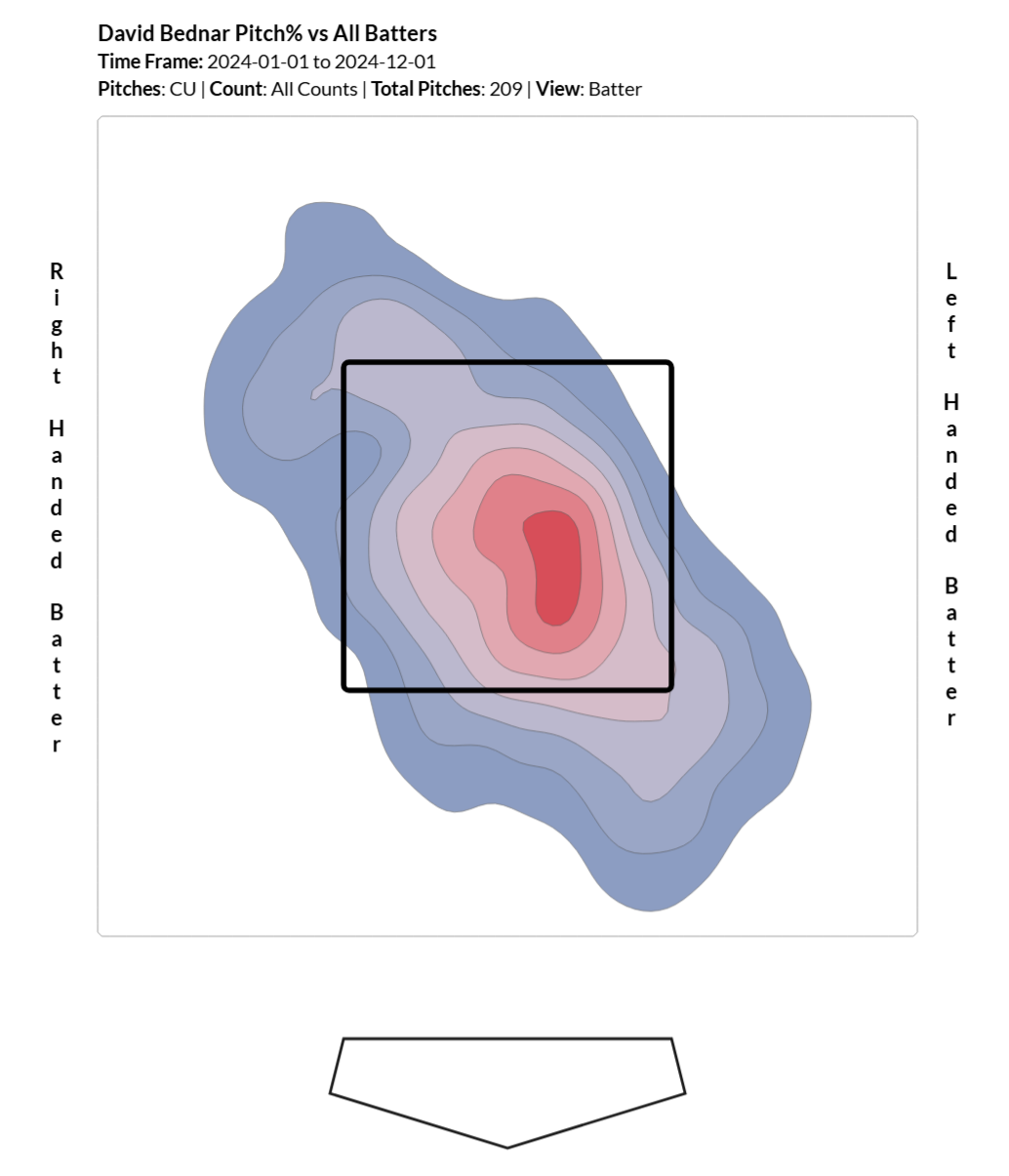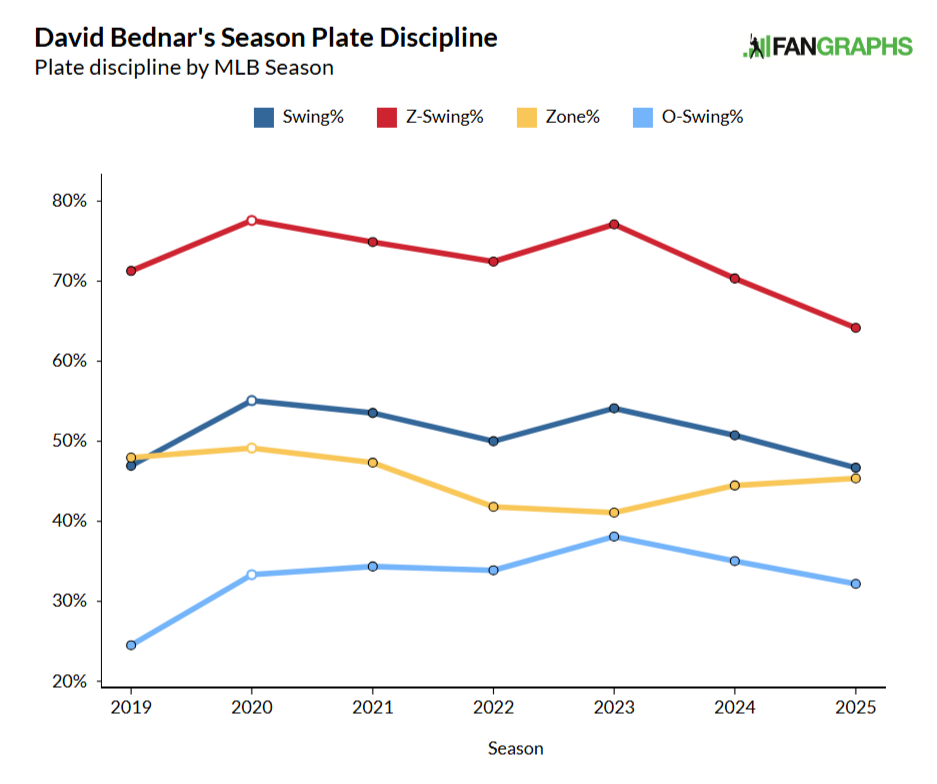Longtime readers of this site might remember my tremendous affection for Pittsburgh reliever David Bednar. It’s OK if you don’t; I last wrote about him in May 2023, which is so long ago the Pirates were in first place at the time. Bednar was a rock back in the day, a top-class closer for a team that frequently disappointed. But from 2021 to the end of 2023, he was terrific: ERAs in the low-to-mid-2.00s every year, with strikeout rates in the high 20s and low 30s.
That trend stopped abruptly in 2024. Again, this wasn’t front-page national news; wise fans had by this point learned to ignore any Pirate shorter than 6-foot-6. But Bednar posted a 5.77 ERA, blew a career-worst seven saves, and saw his strikeout rate plummet to 22.1%, more than 10 percentage points from where it was two years earlier.
A sad development, but not an unforeseeable one. Relief pitchers, even good ones, even reliable ones, have a shorter shelf life than most condiments. But he’s back this year; in 36 games, Bednar has a 2.53 ERA, a career-high 34.6% strikeout rate, a 6.9% walk rate (his lowest since he joined the Pirates five years ago), a 2.02 FIP, and 13 saves out of 13 opportunities.
Surprisingly little changed in Bednar’s game from 2023 to 2024 to 2025. He still throws an upper-90s fastball, a tight, high-70s curveball, and a low-90s splitter. His velocity has been consistent, as has his pitch mix. Bednar is an old-school power closer; there’s none of that newfangled quality-of-contact suppression here. No trendy pitch design or anything, just straight diesel all the way through.
Here’s the interesting thing. Bednar’s opponent chase and whiff rates both dropped significantly from 2023 to 2024, which is the kind of thing you’d expect to see when a pitcher watches his walk rate rise from 7.6% to 10.7%, while more than tripling his HR/9.
But his whiff rate has rebounded only slightly, and his opponent chase rate has actually dropped to 27.8%. Meanwhile, Bednar is throwing in the zone 53.7% of the time, the highest mark he’s posted during his Pirates career.
Now, there’s throwing strikes and then there’s actually commanding the ball. Given Bednar’s increased in-zone rate and the significant drop in his walk rate, it’s fair to say he’s gotten some control back. In order to evaluate his command, well, take a look at these two graphs. Here are Bednar’s curveball locations this season:
Bednar likes to throw the hook not only as a chase pitch, but as a change-of-pace offering, too. With its 20-mph speed differential to the fastball and sharp downward movement, it’s almost a changeup as well as a breaking ball. That means he’ll bury it when he has to, but he also uses it to freeze hitters in the zone and steal called strikes from time to time. Still, we’re looking at a lot of curveballs in the southeast corner of the zone, from the catcher’s point of view, reflecting the natural glove-side movement of the pitch. It’s in the zone, but he’s keeping it down.
Compare that to 2024:
Now, I don’t know much about pitching, but I’ve been told it’s bad practice to bullseye the strike zone like this with any pitch, let alone a slow breaking ball. There’s a word for it, give me a second to thin. Coatrack? No, I’ve got it: They call this a hanger.
To my absolute shock, Bednar still held opponents to a .313 wOBA on his curveball last year, which is up 100 points from 2023 but exactly the same as his figure this season. Only one of the career-high nine home runs he surrendered in 2024 came on the deuce.
What I can tell you is he had a lower whiff rate on the curve in 2024 than in either 2023 or 2025, and his average exit velo on the pitch — in the high 70s in 2023 and 2025 — was 89.0 mph in 2024. His xwOBA on his curveball is down from .269 in 2024 to .164 this year. He’s throwing it in better spots and getting better results.
Consequently, he’s using it more frequently to put hitters away. Bednar’s curveball rate when ahead in the count has doubled since last season.
David Bednar’s Pitch Usage When Ahead in the Count
| Pitch | Year | Pitch% | wOBA | xwOBA | Whiff% |
|---|---|---|---|---|---|
| Fastball | 2024 | 50.0 | .235 | .204 | 21.5 |
| Fastball | 2025 | 43.9 | .126 | .252 | 14.7 |
| Curveball | 2024 | 16.8 | .090 | .068 | 34.8 |
| Curveball | 2025 | 32.5 | .159 | .084 | 38.1 |
| Splitter | 2024 | 33.2 | .107 | .156 | 30.0 |
| Splitter | 2025 | 23.6 | .252 | .203 | 40.0 |
SOURCE: Baseball Savant
You’d think that when Bednar arrives in an advantageous count and whips out that unholy spinning orb of molten cobalt he calls a curveball, he’s gonna get guys to chase, right? Well, no. Like I said earlier, hitters aren’t swinging at many of his pitches outside the zone.
Here’s the cool part. Or the weird part. Or the part that makes this entire resurgence seem a little rickety — take your pick. Hitters aren’t swinging at anything, anywhere. And despite Bednar pitching within the zone more than ever, they’re swinging at pitches inside the zone least of all.
In 2023, Bednar got a called strike on 12.9% of his total pitches. That rose to 14.7% in 2024. This year, that’s up to 18.7%. If they’re not going to swing, you might as well pound the zone. Maybe hitters will figure this out eventually, but they haven’t yet.
The Pirates are 39-58 at the break, once again in last place. And while Bednar is the consummate local boy made good, he turns 31 in October and has just one year of team control beyond 2025. That means you’re going to see him mentioned in trade rumors over the next two weeks. Which wouldn’t have happened last year, when Bednar was getting homered to death and his ERA was more than twice what it is now. Incredible what hitting your spots and stealing strikes can do.
Content Source: blogs.fangraphs.com



